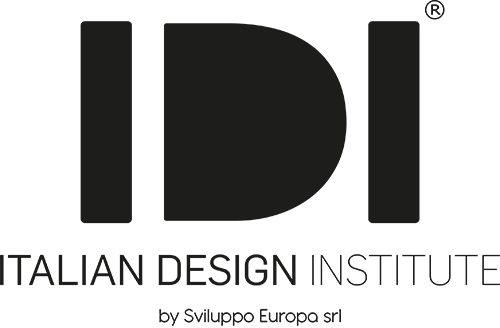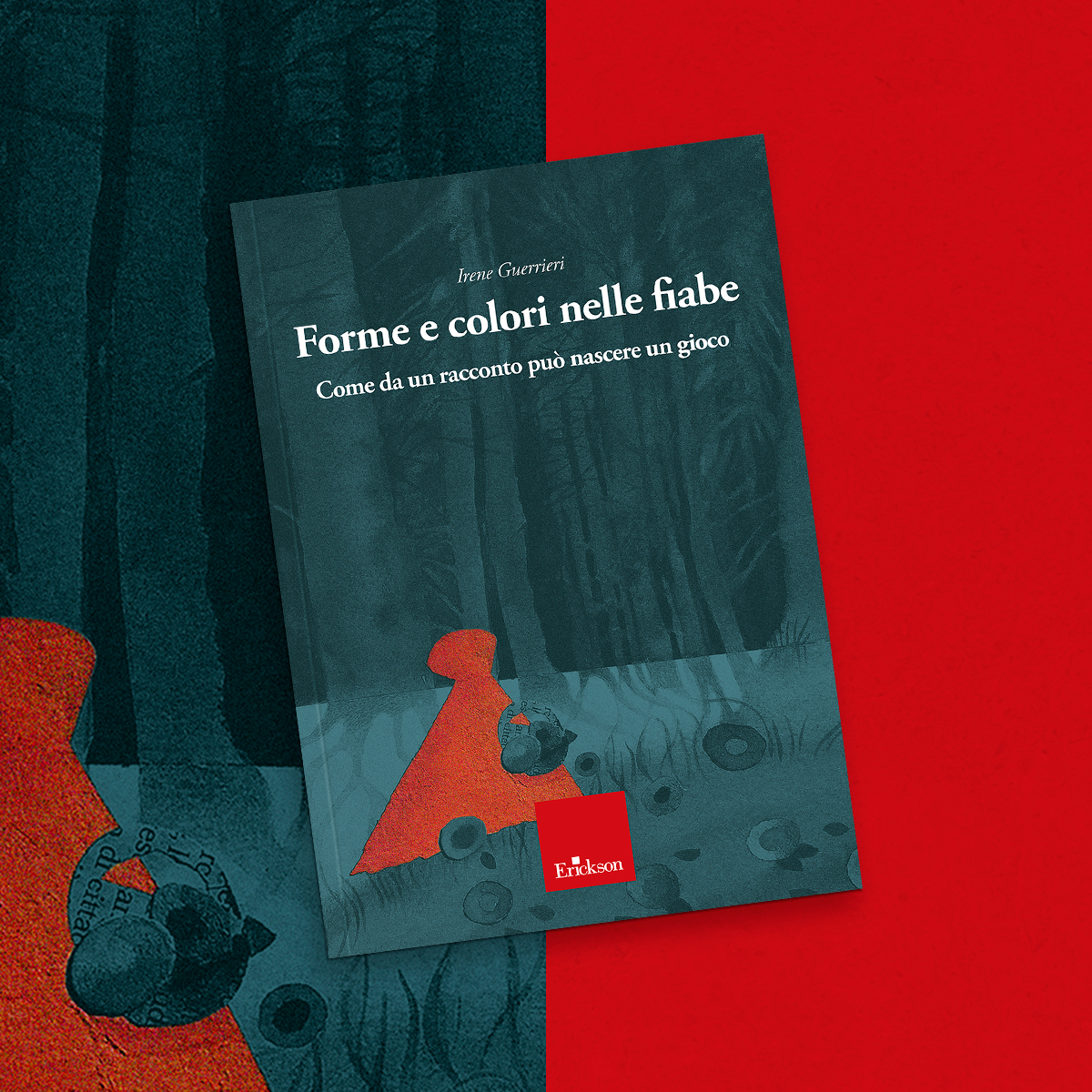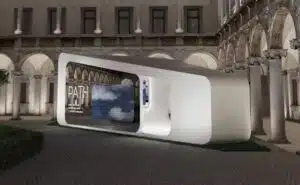“What prevents us from forgetting the fairy tales is the simplicity that makes their figures mysteriously real and close: is there an image capable of giving us courage as much as a red cape going merrily off in the dark of the woods? And wouldn't fear, if we could see it, have a pointed wolf snout? By inviting the reader to follow a method based on observation and synthesis (and to ask the child within him for help), this book teaches the reader to recognise the shapes, colours and symbols through which the fairy tale has always spoken to us and to transform them into something even more universal: into games and toys for children of all ages.
These few words would be enough to restore our sense and entice us to read the Irene Guerrieri's new book 'Shapes and colours in fairy tales. How a game can be born from a tale'. published by Erickson.
The author, who is also a lecturer in the specialisation course in Toys Design by Italian Design Institutetakes us on a journey of "Darkness and light, with magic and quest, joy and danger becoming objects to be manipulated, rules to be respected, enchanted paths to be made, unmade and remade... With the certainty that, as usually happens when you find yourself under the sky of the fairy tale, everything will eventually have a meaning. Even and especially the simplest'.
Roman, architect, Irene Guerrieri graduated in 1992 with a thesis in industrial drawing on the design of a children's park inspired by the fable of Pinocchio. He dedicates his research and his entire professional activity to the study of design, with particular attention to the design for children and educational play, and with leading companies in both
Italy and abroad, he has realised and still realises many products on the global market, winning numerous awards and participating in international exhibitions.
A lecturer in toy design, he holds seminars and workshops at universities and specialisation schools. As expressive languages she prefers painting and illustration. She is the author of the book Il giocattolo e il suo design. From concept to realisation. A guide for the designer (FrancoAngeli, 2021).
We met with her to hear about her book, her work and her passion for games as a fundamental educational experience in everyone's life. We also noted with enormous satisfaction that the work of two former students of the IDI Toys Design course actively participated with their own projects in the realisation of the volume.
Can you briefly tell us about your latest book?
My book introduces a working method that starts with an analysis of the fairy tale as an educational tool, which can be read through the recognition of the shapes and colours present in it, and then translates this analysis into an experience of designing a toy. After all, what more suitable language, if not that present in the fairy tale, from which to draw in order to visualise educational concepts applicable to a play activity? As I often say when I address my students: the fairy tale is a very important tool of the trade for finding the right language, both formal and chromatic, with which to address children. A toy designer cannot do without this useful tool. We therefore start from the fairy tale to set up a project, and then depart from it, if we find it appropriate, in the development phase. The fairy tale represents a starting point but also a world in which the designer himself needs to rediscover his childlike soul, to regain possession of the appropriate language to use to set up his project. So we start from the fairy tale to arrive at the project, where the elements, if well visualised, constitute the right pawns with which to move. Designing, after all, means visualising an idea, giving vent to the imagination, which takes its cue from previously received concepts. And what better concepts than those transmitted to us by the fairy tales that accompanied our childhood, and which therefore know how to awaken our inner child, and along with him our creativity? The book therefore offers a method to which it is necessary to add a good ability to listen to the stimuli that the fairy tale offers and also a certain sensitivity. During my toy design courses, I met good observers, capable of listening to their senses and giving space to their imagination; with them, it was easy to translate the contents of fairy tales into shapes and colours to be placed in space and time and to be used to create an educational play project.
How does a game emerge from a story? What is the underlying process?
I like to read fairy tales from a visual point of view, to grasp the shapes and colours that characterise them, to achieve a formal synthesis of the elements that compose them and then play with these for a creative reinterpretation of the tale, or even simply to obtain new compositions that suggest other activities. It takes creative observation to grasp the parts of a whole, recognise the logical structure that binds them, and return the analysis in terms of appropriate shapes and colours that form the basis of a project dedicated to children. The elements identified in this way are transformed into two- or three-dimensional figures, the colours help in their collocation, and so the game is born, inspired by a narrative. Designing means visualising an idea that takes its cue from previously received concepts. And what better concepts than those conveyed to us by the fairy tales that accompanied our childhood? A good toy designer cannot fail to take this into account and not consider the fairy tale as an indispensable tool of the trade. The process starts with the images we find in it, from which I invite us to grasp the geometry, rules, structure and colours that serve to bring a toy design to life.
How important is play today for children and adults, and how important are stories?
Each of us still remembers the pleasure we felt as a child listening to an adult tell him a fairy tale; and perhaps the memory of that pleasure gave rise to the desire to repeat the gesture, to tell a child in turn the story he kept inside him, or other new stories, to recall and relive such a cherished experience. It is a wheel that turns over and over again and has many meanings, linked above all to the desire to be together, sharing images and dreams. Classic fairy tales contain many elements that help us fulfil this need, making us dream and fantasise. The game is always born around a narrative, its setting is storytelling and the discovery of internalised messages. The game and the fairy tale are important moments in the relationship between adult and child, in which the adult reconnects with his or her child self. We can define it as a moment of bonding and listening, of fantasy and dream. A moment we all have, or have had, a need for. There is an unconscious need to satisfy our imaginative potential and to weave a communication made of fantastic representations: this is what the fairy tale and play offer us.
What is the fairy tale you are most attached to and why?
The fairy tale to which I feel most attached is that of Little Red Riding Hood, because of its colours, particularly the bright red colour, as opposed to the black of the wolf, and also because of the presence of the house and the forest: the house as a representation of a place of departure and arrival, and the forest as the place where the journey takes place, where one can encounter both beauty and danger. I would like to dwell on the formal and chromatic analysis of the elements of the fairy tale, which constitutes the proposal of this book. To represent Little Red Riding Hood, I chose the geometric shape of the triangle, which reminds me of his hood or cape, and as a colour of course red, but which can also become, blue, green, yellow, as Munari teaches us, which places no limits on the expression of the imagination. The red triangle obviously refers us also to other images, but for me it remains the optimal synthesis to represent the main character of this fairy tale, and obviously the triangle is an interesting geometric figure capable of giving life to various compositions, if well placed with other elements. Even the wolf can be represented with a triangle, but with the point down, black and pointed, so as to convey the concept of danger. Thus from a simple geometric figure, such as that of the triangle, many other ideas can spring forth, giving life to the game, a game that is made up of shapes and colours, of spontaneous or guided compositions, but which correspond to a common thread that is linked to the narrative.
Design, planning and storytelling: how do these three concepts harmonise?
Three concepts very dear to me, in continuous dialogue with each other. Design is the result of a design process that starts with storytelling. the true designer is an observer who knows how to draw from the reality around him the images that stimulate him and how to give them communicative value. He draws in particular from nature, the 'fuel' of his creativity, and finds the creative solution in fairy tales and storytelling. When we draw a triangle, we associate with that shape a series of images that we find in our memory. If we draw it red, only some of the images we thought of before come back to us: the field narrows. If we draw a dot on a sheet of paper, we only see a dot; if we draw three, we also see a triangle. If we perform the analysis in the opposite direction, i.e. starting from the image, we identify a series of geometric figures that simplify the image, and we realise that by playing with them we can derive many other narratives and combinations that can explain the contents of the story. In the same way that one can visually imagine a story by deriving the elements for a game, by playing with images one can derive narrative content. Indeed, the game arises, just like the narrative, from the relationship of the figures to each other, and from the formal synthesis we make of the elements. All this presupposes design work that distinguishes the designer.
Painting and illustration are your favourite expressive languages...why? What do they allow you to do?
I started painting and illustration before I became an architect. Figurative art in general has accompanied my education and continues to accompany my profession. I find that through it, man can express his essence and give an individual interpretation of his surroundings. Like design, painting and illustration require careful observation of reality before being able to reinterpret it in a compositional and chromatic language that takes inspiration from the different suggestions received. The human soul is like a sponge: it absorbs everything it sees with sensitivity and an extreme need to receive nourishment from it, and then returns it in unique and unrepeatable artistic products. Painting and illustration allow this. The difference between the two activities is that while the former is interested in the production of an absolutely unique work, the latter is also interested in its reproducibility, taking into account its descriptive and communicative role, aimed at interpreting the scene of a narrative and guiding the reader in imagining the facts. While the former is freer, and in a way more therapeutic, the latter is more guided and embedded in a path, which is the narrative one. In both activities, I find the beauty of playing with the shapes and colours that I prepare at my disposal, as well as with the material of the pigments and supports that accommodate my work.
Have the trainees of the Italian Design Institute's Toys Design specialisation course been able to give voice to their creativity?
The courses I run with the IDI are intensive courses that include a classroom phase and an individual phase to develop the project set up in the classroom. Students participate in my lessons with great passion, and the first important step they take is to get back into dialogue with their inner child. This is an essential step for anyone who wants to become a toy designer, because the design language to be adopted must be simple, clear, and must take into account the needs of the youngest children. You can achieve this if you put yourself on their side and practise looking at things through their eyes, with the curiosity and need for discovery typical of children. I have encountered students who were excellent observers, sensitive souls, and sufficiently children, who gave rise to very interesting creative processes. Some of them were rewarded by having their projects, born in the classroom, put into production by companies operating in the sector that I indicated to them. The course I run with the IDI has a tangible reality, confirmed over the years. The partner companies that support the course are invited by me as a testimony to the reality of production, but also to launch a theme for the students to work on, which concerns their own particular and temporal research, and on which they wish to receive ideas. So the students are invited to engage and develop their project on a concrete request, and this is very stimulating and enriching. At the end of the course each student receives a full review of the work from me, and an indication of companies to which they can forward the project, in addition to the partner company that launched the brief.
What is and what should be, today, the role of a designer dealing with the world of children?
The designer must first and foremost be a good observer, able to grasp the reality around him and the primary needs of the recipients of his designs. His role is also that of an educator, because a good design for children cannot fail to take into account the natural needs of growth, development and learning. In fact, I prefer to speak of an 'educational toy', rather than using the generic term 'toy'. In fact, specifying that a toy is educational implies not forgetting this very important aspect. Children in fact do not need toys, except to learn some concept through them, or to develop some skill. The manipulation and use of toy objects must always have an educational purpose, from which the designer cannot exempt himself. In this role, the designer must correctly identify the language to be used, and simplify every creative idea as much as possible, while also leaving a certain openness to play, and somehow making the recipient of his proposal 'complete the project'. In simple terms, every game should have more possibilities for use and stimulate design creativity in the user as well. The designer's task is therefore to launch the open proposal, and the recipient's response must materialise in a creative and stimulating use of the product, so that the object can stimulate new skills.
What does it take to become a toy designer?
Becoming a toy designer requires a good predisposition for play, careful observation of the target group of the proposals, i.e. children, and an ability to see things from their point of view. Then of course you need good ideas, and the ability to visualise them. It is not an easy job, but it can be very passionate in those who believe in it. After all, dedicating one's time to creating objects for children is a bit like 'taking care of man', his growth, his education, the development of his skills.
How has the way of playing changed today?
The world we live in is not an easy one, the vast supply of perfectly packaged technological games on the market today severely limits the innate potential of children, which is enormous and needs to be developed. Today, games are mostly played while sitting, mostly in front of a screen, nailed to a keyboard, or by manoeuvring small buttons on a joystick, resulting in a tendency towards isolation and the perception of a distorted reality. This trend is not helping children to bring out the best in themselves, but flattening and standardising them, leaving the manipulative power in the hands of major commercial brands. Breaking out of this system is not easy, but something can be done: a designer who cares about his target audience has a duty to produce beauty and circulate intelligent proposals on the market, which do not only stimulate fine motor skills linked to the use of small buttons, but also sociability, outdoor activities, relationships, communication, and the development of cognitive and emotional skills, not bound solely to the screen. The difference lies precisely between analogue and digital play: we cannot abandon the former, even though we cannot fail to come to terms with the latter.





